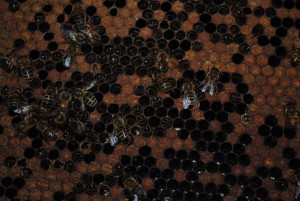Ouch
It’s amazing how often I fail to follow my own advice…’sad’ might be a better way of putting it.
This past weekend, I held the second class in the annual Beekeeping 101 seminar that I do every year. Part of this session included a lengthy session titled ‘Managing Your Hive’ by me. There are several key points to this presentation, but one of them focuses on journals. They are very important and it is equally important to make sure you review them on occasion.
This past Sunday, I made another run of hives out in the hinterlands. Things are really looking up – hives are working on several frames (I have one hive working on 5 frames, but that seems to be the exception). When I say ‘working on’, I basically mean that the queen has brood (at some age) on the frames. This is a big ‘tell’ sign and a definite prerequisite of building Nuc’s (I want the queen to be working 7 frames before I pull a Nuc off of them.) Honey stores look good and things are shaping up nicely.
Then I gave my Overwintered Nuc’s a look…

I immediately noticed dead bees on the landing board of the 4th Nuc that I checked. Despite the fact that the loss is not going to be a big loss (in the scheme of things) it still felt like a gut punch. I pried the top off, hoping beyond hope that everything was ok. Once I got into the hive, I had the picture perfect view of a hive that was in the last throws of starvation. It was truly amazing. I literally have nearly 3 supers of capped honey in my basement alone – this doesn’t count a few supers that remain on hives (out in the ‘hinterlands’!) as bank supers. I really could not believe my eyes. I had checked all of my Nuc’s in January. I found that 2 of the ones that I created in August were light and had given both of them several Medium frames of honey. Was this one of them? Did they go through 3 frames of honey in one month?!
So, after breaking down the Nuc and prepping the frames for a quick (48 hours) freeze, I went back to the old journal to get an accurate look. And there it was… This was indeed one of my late Nuc’s. I had come to the conclusion in January that creating Overwintered Nucs in August was not early enough for me. They could get to critical mass, but they could not store enough honey for the Winter. So, I would only create them this late (in the future) if I had plenty of extra capped honey to give them. BUT, I had not gotten to this ONE hive in my January inspection. I had a clear note – check this Nuc asap – no visibility yet on the amount of stores left! I had checked all of the Nuc’s in my Nuc Yard but this one and KNEW it! But, due to life and other things, had forgotten this ‘to do’ item. Now, I have paid a painful price for it.
The truth of the matter is that ‘these things happen’, regardless of how often you might tell yourself that they don’t happen to me (this is actually the 2nd Nuc that I have had die on me due to starvation since I started doing Overwintered Nuc’s.) But, it is definitely a learning event. Starvation is something a beekeeper can prevent. Whereas I do not believe you should spend the Winter feeding your mature hives, I do believe that Overwintered Nuc’s should be fed and it’s really not a lot of work if you have frames of honey ready for them. It’s a failing on my part and I am taking steps today to prevent this from happening again in the future. To manage this, I am building a web app to track my hives and inspections here : http://www.richmondbeekeeping.com/index.php?page=testp . I hope to be finished by this weekend, at which point I can make sure that all hives are stored and tracked.
This should prevent future issues. We’ll see…
